Antibacterial properties of copper. Is copper antibacterial?

Did you know that copper has antibacterial properties? In ancient times, i.e., several thousand years before the discovery of pathogens and their pathogenicity, copper was used for medicinal and hygienic purposes, for instance, in the water purification process and treatment of wounds and ulcers. In spite of the fact that this is one of the first metals known to man, it still comes as a surprise to scientists. Copper can inactivate even dangerous and antibiotic-resistant bacteria, such as methicillin resistant Staphylococcus aureus (MRSA). What is more, SARS-COV-2 has a very short lifespan on copper surfaces!
History of the copper use
It would be no exaggeration to say that copper has contributed to the development of great civilisations, and without it, a man would not have achieved so much! Copper is 100% recyclable, corrosion-resistant, tough and ductile. In addition, it is a great conductor of heat and electricity and easy to alloy. Its antibacterial and antimicrobial properties of copper are being increasingly verified and used! As a leading copper producer in Europe, we can easily say that copper surrounds us.
At present, as a result of the SARS-CoV-2 pandemic and other severe infectious disease outbreak, copper is more widely used in the healthcare industry.
Does copper have antibacterial properties
As a matter of fact, copper and its alloys have antibacterial properties and this has been known since ancient times. Despite the fact that no one had heard of microorganisms, copper was used both to purify drinking water and to treat diseases, for instance wounds and inflammations.
Nowadays, the above-mentioned properties are used, among others, in:
- fungicides,
- antifouling paint,
- antimicrobial drugs,
- oral hygiene products,
- medical equipment,
- antiseptics.
- The antibacterial properties of copper were scientifically proven, and today the scientific world is intensively testing its ability to inactivate other pathogens. Copper and its alloys are used to reduce the spread of infection in medical facilities, food processing and HVAC systems.
Starting from Escherichia coli and ending up with methicillin resistant Staphylococcus aureus.
Pure copper and its alloys have natural properties to destroy microorganisms. The surfaces of the metal or alloy simply kill bacteria, viruses or fungi. Research is being conducted around the world to show which specific pathogens are killed and to what extent. It was established that the following pathogens are inactivated:
- Escherichia coli,
- Streptococcus,
- Staphylococcus,
- Staphylococcus aureus – MRSA,
- Influenza A virus.
During the SARS-CoV-2 pandemic, it was studied how long SARS-CoV-2 can survive on the surfaces. The study shows that the coronavirus may remain on copper surfaces for only 4 hours, while on plastic and steel for up to 3 days!
Use of copper on touch surfaces
Microorganisms have the ability to persist and survive for long-time periods on surfaces. Even a single and quick touch allows them to enter the human body. The problem is of great concern for hospitals and other medical facilities whose patients have weakened immune systems and are likely to get infections more frequently. Surfaces such as table tops, door handles, light switches, handrails, drip stands and wheelchairs are constantly contaminated with bacteria, including methicillin resistant Staphylococcus aureus.
Basic infection control measures, i.e., hand disinfection and washing are often neglected and turn out to be insufficient. Therefore, for some time now, medical equipment in healthcare centers has been replaced by new equipment made from copper and its alloys.
In 2008, the U.S. EPA, the Environmental Protection Agency, approved the registration of a number of copper alloys as antimicrobial materials (first solid surface material to receive this type of EPA registration,). The studies supervised by EPA have demonstrated copper’s ability to kill more than 99.9% of the disease-causing bacteria within 2 hours.
In addition, the EPA points out that copper surfaces can also be used successfully in public buildings and privately-owned houses.
Healing properties of copper in an epidemic reality
The COVID-19 epidemic has turned our world upside down! Although epidemics are nothing new to mankind, the current situation is a huge challenge for all of us.
In spite of the fact that we have learned to reduce the spread of viruses and bacteria by developing medicines, vaccines and hygiene standards, the diseases caused by them kill hundreds of thousands of people around the world. The use of copper and its alloys on touch surfaces (especially in public spaces), together with a hygiene promotion programme can reduce the risk of transmission of infection, and limit the development of drug-resistant strains of bacteria and, of course, the number of cases of disease.
Use of copper in HVAC systems
Touch surfaces are breeding ground for bacteria and fungi, but they’re not the only places – these are also the dark and damp corners of HVAC systems (ventilation, air conditioning and heating) that are commonly used in homes, schools, offices, shopping centers, i.e., the entire building industry.
Aluminum or steel components have no antibacterial properties. Although the HVAC systems must be cleaned on a regular basis, this may turn out to be insufficient. According to the studies, heat exchangers and cooling coils are breeding grounds for pathogens. Preliminary tests carried out, among others, at university centers, show that copper components of the HVAC system can reduce bacterial and fungal loads by more than 99%!
Copper is man’s oldest metal, and can effectively protect people against infectious diseases by being used on metal surfaces all over the world! At Electris, we are proud of the fact that our copper components may contribute to a safer reality!



